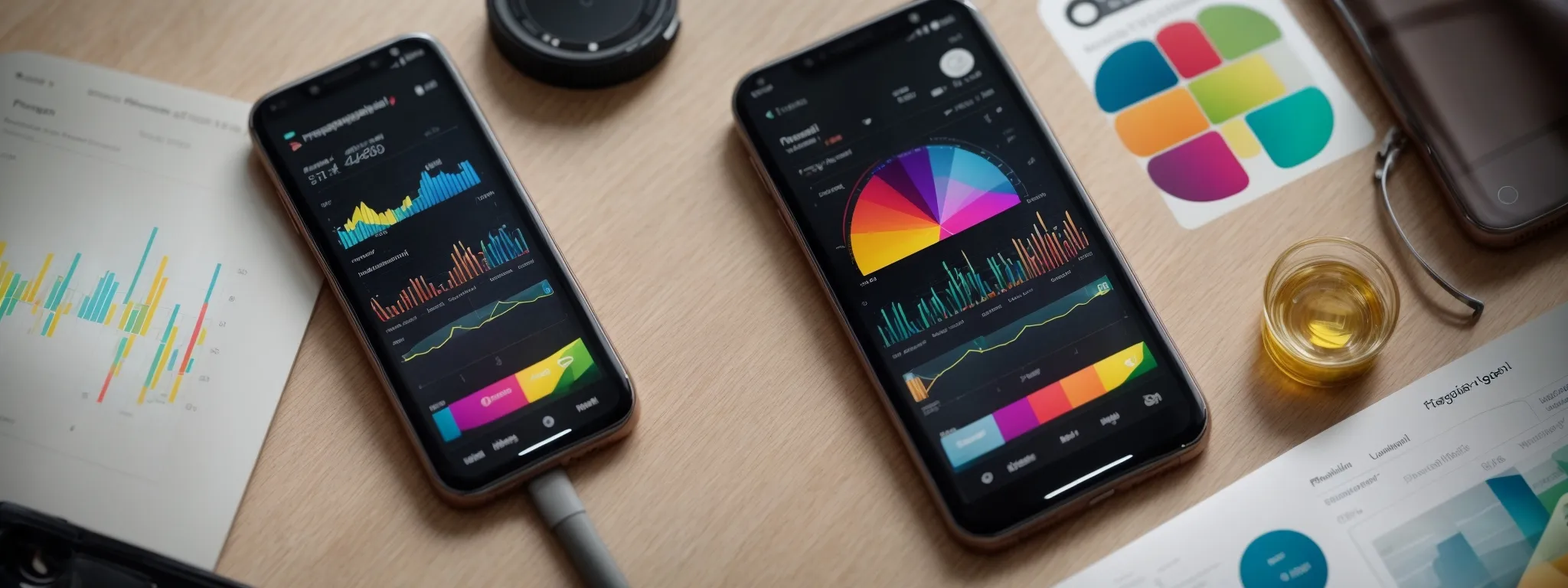ASO Strategies: Tools for Success
Maximizing Your App’s Visibility: Essential ASO Strategies and Tools for Success In the competitive landscape of mobile app development, App Store Optimization (ASO) stands as the keystone […]
Maximizing Your App’s Visibility: Essential ASO Strategies and Tools for Success
In the competitive landscape of mobile app development, App Store Optimization (ASO) stands as the keystone of success, ensuring that your app rises above the noise to capture user attention.
By grasping the fundamentals of ASO, harnessing the power of targeted keyword research, and deploying sophisticated analytics, app creators can propel their digital offerings to new heights.
Tools designed for elevating app visibility not only aid in outshining rivals but also play a pivotal role in unlocking sustained growth and user engagement.
Keep reading to uncover the essential tools and strategies that promise to refine your ASO practices and escalate your app’s market presence.
Key Takeaways
- App Store Optimization Is Critical for Increasing an App’s Visibility and Download Numbers
- Strategic Keyword Research and Metadata Optimization Are Central to Effective ASO
- Free ASO Tools Like Google Keyword Planner Offer a Foundation for Keyword Optimization
- Premium ASO Tools Provide Advanced Features for Detailed Analysis and Market Intelligence
- Continuous Data Analysis and Adaptation of Keywords Are Necessary to Maintain Competitive ASO Practices
Understanding the Basics of App Store Optimization

In the dynamic landscape of mobile marketing, App Store Optimization (ASO) stands as an essential practice for developers and marketers aiming to increase an app’s visibility among a saturated market.
At its core, ASO is a multifaceted strategy tailored to enhance the discoverability of mobile apps within app stores.
The significance of ASO cannot be overstated, as it directly influences an app’s standings in search results, thereby impacting download numbers and overall success.
Essential components of ASO include meticulous keyword research, a compelling app description, and the integration of user feedback into both metadata and user experience improvements.
The implementation of ASO techniques not only elevates an app’s prominence in search queries but also fine-tunes its presentation to appeal to the target audience effectively, heightening potential user engagement and retention rates.
Explain What ASO Is and Its Importance
App Store Optimization (ASO) is the process by which mobile apps are optimized to rank higher in an app store’s search results: The higher the ranking, the more visible the app is to potential users. This specialized form of optimization encompasses various strategies to increase an app’s search relevancy and keyword coverage, thereby promoting better discoverability and user acquisition.
| ASO Component | Description | Impact |
|---|---|---|
| Keyword Research | Identifying the right keywords that potential users are searching for. | Directly affects the app’s search visibility within app stores. |
| App Description | Creating a compelling description that highlights the app’s features and benefits. | Enhances user interest and persuades potential downloads. |
| User Feedback Incorporation | Using reviews and ratings to improve the app’s features and performance. | Improves user experience and sustains app popularity over time. |
The importance of ASO lies in its direct correlation to an app’s success: As the number of apps in the market grows, so does the competition for user attention. By optimizing the app with ASO best practices, developers can measurably improve the app’s visibility and attractiveness, leading to higher conversion rates and increased revenue opportunities.
Outline the Key Components of ASO
Effective App Store Optimization demands a sound understanding of the app’s target audience and market intelligence. By accumulating and analyzing behavior and search patterns, developers and marketers gain insight into how to position their mobile app effectively, ensuring the app meets the users’ needs and stands out amidst a plethora of similar offerings.
A strategic component of ASO involves the optimization of visual elements such as icons, screenshots, and videos, which work in concert to not only garner attention but also provide a snapshot into the app’s user interface and overall user experience. These creatives must be optimized to convey the app’s value proposition succinctly and attractively, persuading users to install and engage with the app.
Discuss the Impact of ASO on App Visibility
The realm of app visibility is highly dependent on the efficacious application of ASO strategies. With precise implementation, ASO serves as a beacon, guiding the target audience towards an app by enhancing its standing in search results: This pivotal positioning is often the difference between an app’s obscurity and its prominence.
Central to ASO’s efficacy is the app’s conversion rate – the metric that signifies the percentage of store visitors who proceed to install. Rigorous ASO efforts bolster this rate, ensuring that an app not only gains visibility but also capitalizes on it to fuel downloads and, by extension, boost revenue generation.
- App visibility sees a marked uplift through strategic keyword insertion, driving the app’s search rankings to the upper echelons of results.
- Increased visibility translates to heightened discoverability, enabling potential users to find the app more readily amidst a vast and crowded marketplace.
- With improved discoverability, apps witness enhanced user engagement, fostering a cycle of positive reviews and ratings that further perpetuate visibility gains.
Leveraging Keyword Tools to Improve ASO

For app developers and marketers honing their ASO strategy, the judicious use of keywords stands as a cornerstone for boosting an app’s stature within the congested ecosystem of app stores.
The journey to ASO mastery involves not only discerning the significance of keywords but also selecting the right tools to unearth ones that resonate with the target audience.
Implementing these terms into an app’s metadata with precision ensures that pertinent features and functionalities are spotlighted, paving the way for both improved search rankings and user relevancy.
The ensuing discussion outlines the pivotal role of keywords in ASO, evaluates the efficacy of leading keyword research tools, and navigates the meticulous process of integrating keywords to optimize an app’s market presence.
Identify the Role of Keywords in ASO
In the sphere of ASO, keywords act as the compass that directs potential users to an app: Their strategic deployment within an app’s title, description, and metadata is fundamental to improving search discoverability. Thus, keywords serve as a crucial element in connecting with the intended audience, where relevance and conciseness are paramount.
Keywords, therefore, enable a mobile app to rank for specific search queries, enhancing its visibility in a crowded marketplace: The appropriate selection and utilization of keywords can dramatically alter an app’s trajectory, transforming it from overlooked to highly sought after:
- Selection of high-performing keywords drives targeted user traffic.
- Integration of keywords into app metadata optimizes search relevancy.
- Continuous keyword analysis adapts to changing market trends and user behaviors.
Review Popular Keyword Research Tools for App Stores
The arsenal of a savvy mobile marketer invariably includes Advanced Keyword Research Tools, which offer an invaluable means to delve into the psyche of the app store’s search engine algorithms. By harnessing these tools, marketers can uncover the optimal keywords that align with their app’s core features and user search intent, empowering them to elevate their app’s position in store rankings and edge out competition.
While many platforms offer insights into keyword effectiveness, a select few command widespread recognition for their comprehensive analytics and robust data sets. These renowned tools provide a granular view of keyword performance, enabling a surgical approach to keyword optimization that can significantly augment an app’s search engine visibility and strengthen its overall ASO strategy.
Demonstrate How to Implement Keywords Into Your App’s Metadata
Integrating keywords into an app’s metadata demands careful consideration and strategy. Developers must meticulously incorporate relevant keywords into the app title, subtitle, and descriptions, ensuring they are naturally woven into the text to maintain a coherent and engaging narrative for the potential user.
For metadata optimization to be effective, it is crucial that keywords reflect the unique selling points and functionalities of the app, while aligning with the most common search terms used by the target audience. This synergy between user search intent and app attributes fosters improved app visibility and positions the app favorably in the app store’s algorithm-driven search landscape.
Utilizing Analytics to Refine Your ASO Strategy

An app’s ascent in the mobile marketplace is heavily reliant on the informed decisions made behind the scenes, with App Store Optimization (ASO) forming the bedrock of such strategic plays.
To navigate the intricacies of ASO, developers are increasingly turning to app analytics—a technological compass offering critical insights into an app’s performance.
Leveraging data-driven intelligence allows developers to adjust and fine-tune their ASO tactics, ensuring each action taken is backed by concrete, analytical rigor.
This unification of data and strategy is imperative in not only discerning the efficacy of current efforts but also in shaping future initiatives to secure an app’s prominence and longevity in an ever-evolving digital arena.
Highlight the Significance of App Analytics
Adopting a data-driven approach, developers can use app analytics to detect trends and user behaviors pivotal to refining their ASO efforts. Critical metrics such as engagement rates, retention figures, and user demographics provide actionable insights that pinpoint the strengths and weaknesses within an app’s existing optimization strategies.
By closely monitoring these analytics, developers are empowered to iterate rapidly, adjusting features and keywords to better align with the evolving preferences and search habits of their user base. This adaptive process enhances the app’s relevance and attractiveness, making analytics an indispensable tool for maintaining Competitive ASO Practices.
Recommend Analytics Tools to Track Your App’s Performance
To ensure a data-informed approach to ASO, selecting a robust analytics tool is imperative for developers aiming to track their app’s performance efficiently. Tools such as Google’s Firebase provide Comprehensive App Analytics, offering insights into user behavior, conversion data, and app stability issues which are crucial for optimizing ASO strategies.
Another powerful resource in the realm of ASO is Apple’s App Analytics that comes with the benefit of seamless integration for iOS apps. It delivers a wealth of information including user engagement, marketing campaign effectiveness, and monetization success, equipping developers with the vital statistics needed to make informed decisions on improving their app’s store performance.
Show How to Use Analytics Data to Optimize ASO Efforts
Integrating analytics into the App Store Optimization process allows for a targeted approach to application improvement. By analyzing user interaction data, developers can discern which features resonate with users and which require refinement: The result is an informed strategy that emphasizes successful app characteristics while addressing underperforming aspects.
- Review user engagement metrics to understand which app features keep users returning.
- Evaluate conversion rates to determine the effectiveness of current ASO strategies.
- Monitor keyword performance to adjust metadata for optimal search engine placement.
Armed with analytics insights, developers are equipped to fine-tune keywords, streamline user interfaces, and enhance overall user experience. This data-driven optimization pays dividends by elevating the app’s visibility, driving more downloads and ultimately fortifying its position in a highly competitive digital marketplace.
Increasing Visibility With App Marketing Tools

In an age where the digital landscape is ever-expanding, the imperative for applications to rise above the noise hinges on a robust App Store Optimization (ASO) strategy, accentuated by effective app marketing tools.
These tools are the lifeline of savvy marketers, augmenting core ASO efforts by broadening an app’s reach and fostering its visibility.
Efficiently leveraging such tools requires an understanding of their capability to complement ASO strategies, assessing which among them can significantly amplify an app’s presence, and meticulously integrating them into a refined ASO plan.
In the forthcoming discourse, there will be an exploration of how these marketing instruments can be harnessed to enhance an app’s prominence, thus serving as critical adjuncts in the quest for superior app marketplace positioning.
Explore How Marketing Tools Complement ASO Strategies
Marketing tools serve as a crucial adjunct to App Store Optimization, bridging the gap between ASO technicalities and market engagement. Through targeted campaigns such as pay-per-click Google Ads or social media marketing, these tools can significantly amplify an app’s reach, enhancing its visibility well beyond the confines of app store search results.
By coordinating ASO efforts with the strategic dissemination of digital PR services and influencer marketing, developers can ensure a consistent message that resonates across multiple channels. This synchronization not only fortifies the app’s brand presence but also drives organic traffic, reinforcing the app’s standing within the digital marketplace.
Evaluate Which App Marketing Tools Can Boost Visibility
Discerning which app marketing tools can enhance an app’s visibility necessitates a strategic approach that aligns with the app’s branding and audience. Tools like PPC Google Ads offer the precision targeting necessary to reach segmented audiences, while digital PR services can expand the app’s reach and reputation across a wider, yet still relevant, user base.
Further, social media marketing stands out as a formidable tool, providing a platform for apps to engage users with compelling content and drive word-of-mouth promotion. Leveraging these tools in synergy with a solid ASO foundation propels an app’s visibility, drawing increased attention from potential users and stakeholders in the digital ecosystem.
Provide Steps for Integrating Marketing Tools Into an ASO Plan
Embarking on the integration of marketing tools into an ASO plan begins with a clear identification of the app’s unique selling propositions and the target audience. A judicious selection of tools such as SearchAtlas by LinkGraph and LinkGraph’s suite of SEO services fosters a tailored approach, ensuring each tool’s capabilities are harnessed to support the app’s core message and reach the desired demographic effectively.
Once the toolbox has been assembled, a Methodical Implementation Schedule is vital; this includes synchronizing the timing of PPC Google Ads campaigns with key app updates or releases, integrating digital PR services to boost authority around the same period, and maintaining a consistent narrative across social media channels to amplify the app’s visibility and enhance user engagement. Coherent efforts such as these are instrumental in maximizing the efficacy of marketing tools within an ASO framework.
Gaining Competitive Edge With App Store SEO Tools

In the fiercely competitive terrain of app stores, one cannot overlook the potency of Search Engine Optimization (SEO) in spurring discoverability for mobile applications.
A well-crafted SEO strategy acts as the linchpin in catalyzing an app’s prominence, distinguishing it from countless titles vying for user attention.
Recognizing the essence of SEO in enhancing app discoverability is paramount for developers seeking to top app store search results.
With specialized SEO tools designed for the app store milieu, developers can adeptly navigate the nuances of the app ecosystem, tailoring their applications to the algorithms that dictate app store rankings.
This introduction serves as a trailblazer for apps to employ SEO principles within their App Store Optimization strategies, setting the stage for how meticulous planning and execution of these practices can amass a significant competitive edge in the app marketplace.
Discuss the Necessity of SEO in Enhancing App Discoverability
In today’s mobile app ecosystem, Search Engine Optimization (SEO) is no longer an optional advantage but a necessity for app developers looking to increase their app’s discoverability. With app stores housing millions of applications, SEO provides the strategic framework for enhancing an app’s visibility, enabling it to rise above the digital din.
SEO for mobile apps requires a nuanced approach, with specific tools and techniques tailored to align with app store algorithms that govern app rankings. By optimizing an app’s listing with relevant keywords and robust metadata, developers can significantly improve the app’s searchability, leading to higher user acquisition rates and sustained app store success.
Assess SEO Tools Specialized for the App Store Environment
In the ascent to app prominence, selecting adept SEO tools specialized for the app store environment becomes indispensable. These tools are expertly designed to decipher the algorithms of app stores, offering precise insights for optimizing listings—from fine-tuning keywords to enhancing metadata.
| SEO Tool | Purpose | Benefit |
|---|---|---|
| Keyword Optimization | To identify and implement high-traffic keywords within app titles and descriptions. | Increases app discoverability in search results, leading to higher download rates. |
| Metadata Analysis | To evaluate and refine the app’s metadata for alignment with app store search criteria. | Enhances app relevance for specific searches, improving chances of user engagement. |
Developers stand to gain a strategic advantage by utilizing these SEO tools effectively: they not only boost an app’s visibility but also enable ongoing optimization to keep pace with competitive market trends and shifting user behaviors.
Guide on Applying SEO Principles to Your ASO Strategy
Applying SEO principles to an app’s ASO strategy requires a balance between creative marketing and analytical rigor. The key is to identify and integrate high-value keywords into the app’s storefront presence, including its title, subtitle, and description, with a focus on maintaining readability and user interest.
This integration of SEO into ASO leads to a more robust and visible app profile: By optimizing for relevant keywords, the app becomes more discoverable to users actively searching for solutions that the app provides. To further expound on this approach:
| Integration Step | Action | Expected Outcome |
|---|---|---|
| Keyword Placement | Strategically include keywords where they have the greatest impact, avoiding overstuffing and ensuring natural flow in the text. | Improves the app’s ranking for targeted searches without compromising user experience. |
| SEO Audits | Conduct regular SEO audits to assess and refine keyword performance over time. | Ensures the app’s ASO strategy evolves with changing market trends, maintaining its competitive edge. |
Exploring Free and Premium ASO Tools for Growth

In the fast-paced world of mobile app development, the right App Store Optimization (ASO) tools can make a substantial difference in an app’s market performance and visibility.
Initiating the journey with free tools can offer startups and solo developers a solid foundation in ASO, while premium options exist to cater to the nuanced needs of larger operations aiming to scale efficiently.
This balance between freely accessible resources and more sophisticated, feature-rich tools presents a spectrum of possibilities for app developers of all magnitudes.
In exploring the array of ASO tools, one can consider the distinct advantages and limitations that come with complimentary versions against their paid counterparts, evaluate the most effective free tools tailor-made for resource-conscious entities, and delve into the advanced capabilities of premium offerings that support burgeoning apps as they navigate their expansion within the competitive mobile landscape.
Compare the Benefits of Free Versus Premium Tools
In the realm of App Store Optimization (ASO), developers are often positioned at a crossroads between utilizing free tools or investing in premium solutions. Free tools provide a cost-effective gateway for startups and independent developers to embark on the optimization journey, allowing access to basic keyword and metadata analytics without incurring financial strain.
Conversely, premium tools offer a depth of features and dedicated support that transcend the capabilities of their free counterparts. These include advanced data analysis, competitor research, and market intelligence—tools that are vital for businesses aiming to refine their ASO strategies and secure a competitive edge in the bustling app marketplace.
List Top Free Tools for Startups and Independent Developers
For startups and independent developers, Google Keyword Planner emerges as a fundamental tool, providing critical insights into keyword search volumes and trends at no cost. This resource enables the identification of relevant keywords to incorporate into an app’s title and description, forming the backbone of a foundational ASO strategy.
Another key free tool is Google Analytics for Firebase, which offers a robust suite of analytics services designed to track app performance and user engagement. By understanding user behavior and app usage patterns, developers can optimize their ASO efforts to better meet the needs of their target audience:
| Free Tool | Primary Function | ASO Benefit |
|---|---|---|
| Google Keyword Planner | Keyword research and planning | Enables data-driven keyword selection to improve app discoverability |
| Google Analytics for Firebase | App performance tracking | Provides insights for informed ASO decisions based on user behavior |
Outline Premium Tools That Offer Advanced Features for Scaling Up
Premium ASO Tools act as the propellant for app growth, endowing developers with sophisticated functionalities that streamline optimization processes and provide extensive market insights. With the ability to assess competitive landscapes, track rank history, and gauge the efficacy of marketing strategies, these enhanced platforms offer a comprehensive suite for scaling operations in an ever-evolving app ecosystem.
Stalwarts in this arena like SearchAtlas by LinkGraph extend their expertise through Advanced Offerings Including Deep Keyword Analysis and white label link building. Their cultivated technologies allow for a granular approach to ASO, ensuring that apps not only climb in visibility but also maintain a robust presence that withstands the test of market fluctuations and algorithm updates.
Conclusion
Maximizing app visibility is crucial in an increasingly crowded digital marketplace, and successful App Store Optimization (ASO) strategies are key to achieving this.
Through rigorous keyword research, crafting compelling app descriptions, and integrating user feedback, developers can significantly impact their app’s search rankings and download rates.
Employing the right mix of free and premium ASO tools allows for effective optimization and scaling.
By tapping into the power of analytics and SEO principles, and augmenting ASO efforts with strategic marketing tools, developers can refine their approach, enhance user engagement, and gain a competitive edge.
Hence, embracing ASO with tailored strategies and the right tools underpins the success of any app in today’s competitive market.














































































